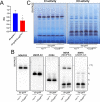Structural rather than catalytic role for mitochondrial respiratory chain supercomplexes
- PMID: 37823874
- PMCID: PMC10569793
- DOI: 10.7554/eLife.88084
Structural rather than catalytic role for mitochondrial respiratory chain supercomplexes
Abstract
Mammalian mitochondrial respiratory chain (MRC) complexes are able to associate into quaternary structures named supercomplexes (SCs), which normally coexist with non-bound individual complexes. The functional significance of SCs has not been fully clarified and the debate has been centered on whether or not they confer catalytic advantages compared with the non-bound individual complexes. Mitochondrial respiratory chain organization does not seem to be conserved in all organisms. In fact, and differently from mammalian species, mitochondria from Drosophila melanogaster tissues are characterized by low amounts of SCs, despite the high metabolic demands and MRC activity shown by these mitochondria. Here, we show that attenuating the biogenesis of individual respiratory chain complexes was accompanied by increased formation of stable SCs, which are missing in Drosophila melanogaster in physiological conditions. This phenomenon was not accompanied by an increase in mitochondrial respiratory activity. Therefore, we conclude that SC formation is necessary to stabilize the complexes in suboptimal biogenesis conditions, but not for the enhancement of respiratory chain catalysis.
Keywords: D. melanogaster; Drosophila; Mitochondria; OXPHOS; biochemistry; chemical biology; supercomplexes.
© 2023, Brischigliaro et al.
Conflict of interest statement
MB, AC, SA, CV, MZ, EF No competing interests declared
Figures










Update of
- doi: 10.1101/2023.04.19.537447
- doi: 10.7554/eLife.88084.1
- doi: 10.7554/eLife.88084.2
References
-
- Assouline Z, Jambou M, Rio M, Bole-Feysot C, de Lonlay P, Barnerias C, Desguerre I, Bonnemains C, Guillermet C, Steffann J, Munnich A, Bonnefont JP, Rötig A, Lebre AS. A constant and similar assembly defect of mitochondrial respiratory chain complex I allows rapid identification of NDUFS4 mutations in patients with Leigh syndrome. Biochimica et Biophysica Acta. 2012;1822:1062–1069. doi: 10.1016/j.bbadis.2012.01.013. - DOI - PubMed
-
- Berndtsson J, Kohler A, Rathore S, Marin‐Buera L, Dawitz H, Diessl J, Kohler V, Barrientos A, Büttner S, Fontanesi F, Ott M. Respiratory supercomplexes enhance electron transport by decreasing cytochrome c diffusion distance. EMBO Reports. 2020;21:e51015. doi: 10.15252/embr.202051015. - DOI - PMC - PubMed
Publication types
MeSH terms
Grants and funding
LinkOut - more resources
Full Text Sources
Molecular Biology Databases

